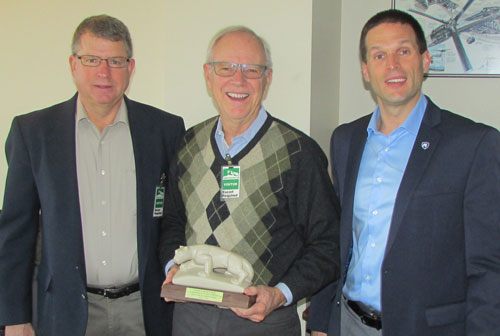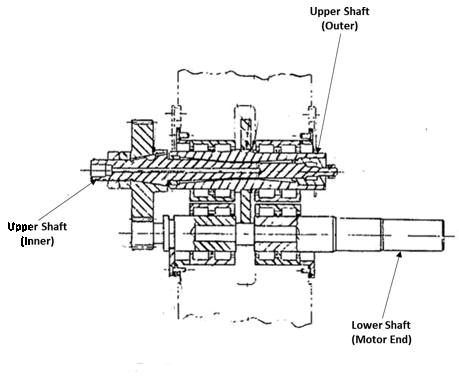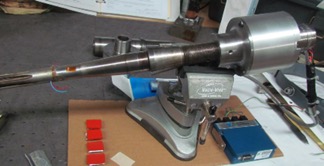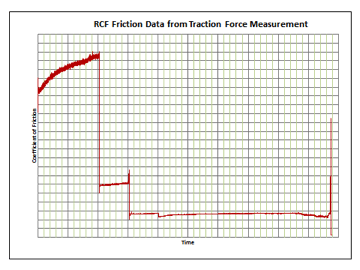Apr 2015 Newsletter - Transmissions Vol 15, 2015
 Vol. 15, 2015
Vol. 15, 2015
Transitions
 I am so very pleased to introduce our new leadership team at GRI. First is my friend Jack Masseth who has been on our Board for a number of years; most recently serving as Board secretary. Jack has accepted the presidency of the Gear Research Institute. He has over thirty years in the gear industry, starting at Gleason Works after receiving his ME degree from RIT in Rochester, NY. Jack is presently the Manager of Advanced Gear Manufacturing Technology at Meritor, Inc. located in Troy MI. Jack and his wife have two grown sons (also engineers). WELCOME JACK..!
I am so very pleased to introduce our new leadership team at GRI. First is my friend Jack Masseth who has been on our Board for a number of years; most recently serving as Board secretary. Jack has accepted the presidency of the Gear Research Institute. He has over thirty years in the gear industry, starting at Gleason Works after receiving his ME degree from RIT in Rochester, NY. Jack is presently the Manager of Advanced Gear Manufacturing Technology at Meritor, Inc. located in Troy MI. Jack and his wife have two grown sons (also engineers). WELCOME JACK..!
 Next is Aaron Isaacson our new Managing Director of the Gear Research Institute. Aaron is a Research and Development Engineer at the Applied Research Laboratory of The Pennsylvania State University. He holds M. S. and B.S. degrees in Mechanical Engineering (Penn State University, Dec. 1998 and May 2009) and is currently pursuing his PhD in Materials Science and Engineering. Aaron began conducting gear and roller testing as an undergraduate student working at ARL in the summer of 1997 and became a full time engineer in January of 1999. He has a dual appointment, working in both the Drivetrain Technology Center and the Materials Processing Department.
Next is Aaron Isaacson our new Managing Director of the Gear Research Institute. Aaron is a Research and Development Engineer at the Applied Research Laboratory of The Pennsylvania State University. He holds M. S. and B.S. degrees in Mechanical Engineering (Penn State University, Dec. 1998 and May 2009) and is currently pursuing his PhD in Materials Science and Engineering. Aaron began conducting gear and roller testing as an undergraduate student working at ARL in the summer of 1997 and became a full time engineer in January of 1999. He has a dual appointment, working in both the Drivetrain Technology Center and the Materials Processing Department.
Aaron took over as Managing Director of the Gear Research Institute in July of 2014. He has over 15 years of experience conducting gear and roller fatigue test programs at all levels, from mechanical setup and machine operation to data analysis/reporting and project management. His research interests include gear performance characterization, failure analysis, gear tooth friction and efficiency, ferrous metallurgy, spray metal forming of aluminum alloys and metal matrix composites, sintering fabrication of composite materials and materials characterization.
 \
\
Sam Haines,
Outgoing President of the GRI Board
Research Project
Significant interest exists in the aerospace gearing community for continued gear operation in reduced lubricant or even complete "loss of lubricant" situations. This would enable the gear box to continue to operate and the aircraft to land safely in case of accidental damage to the system. The response from the industry to this requirement has so far been two fold, besides the increased utilization of gear steels with higher temper temperature. One approach is to develop coatings for the tooth surface that allows the gear to operate under such conditions. The other approach has been to add various compounds to the lubricant that adheres to the tooth flank under normal operating conditions and provides lubrication for a limited time even when the primary lubrication system is shut off. The Gear Research Institute has been involved in several projects with industry in both these approaches.
The efforts to date at the Gear Research Institute have been to evaluate the performance of these coatings and lubricants in simulated "oil off" rotating/sliding contact fatigue (RCF) tests. This type of testing was discussed in detail in the previous newsletter (no. 14, 2014). It is a cylinder on cylinder test with rolling and sliding to simulate the action on the flank of the gear tooth. As shown in figure 1, the schematic of this test, the upper shaft carries the load roller that is in contact with the test specimen on the lower shaft, under load. The test specimen is driven by a variable speed motor and drives the load roller through a specific geared ratio. This geared ratio generates the rolling and sliding motion at the load roller-test specimen interface. The evaluation of "oil-off" performance test is initiated as a standard RCF test with a "break in" under load and with normal lubricant flow. After the "break in" and some normal test time the oil is shut off and the time to pitting, scoring or wear failure is utilized as a measure of the performance of the coating or the particular lubricant or lubricant additive under evaluation.
The other parameter that is of significance in this type of testing is the frictional loss at the contact surface. This frictional loss results in a lowered efficiency and a reduction in this loss would result in improved fuel efficiency in any vehicle utilizing a geared transmission. To obtain the coefficient of friction at the contact surface the parameter to be measured is the traction force exerted at the cylinder on cylinder contact interface. This traction force as a ratio of the normal force is a measure of the coefficient of friction at the interface. This article briefly describes the set up to measure the traction force and the information that was obtained from monitoring this parameter.
In order to measure the traction force between the load roller and the cylindrical test specimen, the upper shaft, which carries the load roller, is split into two concentric shafts, inner and outer. The drive to the load roller is provided by the gearing from the driven, lower shaft to the upper- inner shaft, which is then transmitted to the upper outer shaft and the load roller, through splines at the right hand end of the assembly.

Figure 1: RCF Schematic
A strain gage mounted on the inner shaft, shown in figure 2, measures the torsional strain the inner shaft experiences, which is proportional to the traction force at the interface. Figure 2 also shows the slip ring assembly to transmit the signals from the strain gage to the stationary instrumentation.
A typical measurement is shown in figure 3 which shows the coefficient of friction (ratio of traction force/normal load) as the test proceeds under the boundary lubrication and “loss of lubricant” conditions. As the break-in proceeds and the normal load increased, the coefficient of friction drops till it reaches a steady state value. The lubricant is then shut off at the maximum test load. As the “oil out” condition is engaged the coefficient of friction decreases initially till catastrophic failure at the rolling sliding interface, with significant increases in the coefficient of friction occurs. This experimental procedure provides an accurate measurement of the time that the test specimen survives before failure occurs, while providing a quantitative measure of the friction at the interface.

Figure 2: Strain Gauge Mounted on Shaft

Figure 3: Measurement of Coefficient Friction
Several projects utilizing this measurement methodology are being conducted at the Gear Research Institute for evaluating the performance of thin film coatings and lubricants in a loss of lubricant condition.
Education and Training
In order to assist the gear industry augment its aging work force, the Gear Research Institute has DEVELOPED two initiatives to train more gear knowledgeable engineers at the undergraduate and graduate levels. This involves incorporating engineering undergraduate students, at the junior/senior level and graduate students in the Institute’s research laboratory while being paid by a grant from the sponsoring industrial entity. Summer internships have also been arranged at the sponsor’s facility are also a part of the deal, so that the student and the sponsor have an opportunity to assess each other with future employment in mind.

William Jaundalderis
We had our first graduate of this program in the spring of 2013, who then joined John Deere at their Coffeyville, KS facility. We had a second student selected by John Deere, Byron Stuart, who graduated this spring and joined John Deere at their Waterloo, Iowa facility in August. We now have our third student William Jaundalderis, a senior in Mechanical Engineering working with us and prospectively joining John Deere upon graduation.
Typically, students get hands on experience by setting up and monitoring gear test equipment with additional training topics such as gear metrology, failure analysis, metallurgical characterization, vibration monitoring for failure detection, statistical analysis of test data and more.
For more information about how you can support a student intern please log in to www.gearresearch.org or contact Aaron Isaacson at 814 865 5832 or This email address is being protected from spambots. You need JavaScript enabled to view it..
The Gear Research Institute is a non profit corporation. It has contracted with the Applied Research Laboratory of The Pennsylvania State University to conduct its activities, as a sponsor within the Drivetrain Technology Center. The Gear Research Institute is equipped with extensive research capabilities. These include rolling contact fatigue (RCF) testers for low- and high-temperature roller testing, power circulating (PC) gear testers for parallel axis gears with a 4-inch center distance (testers can be modified to accommodate other center distances), single tooth fatigue (STF) testers for spur, helical and spiral bevel gears, and gear tooth impact tester. Extensive metallurgical characterization facilities are also available at Penn State in support of the Gear Research Institute. For further details on our testing capabilities please go to www.gearresearch.org or call Aaron Isaacson, Managing Director, at (814) 865-5832..
